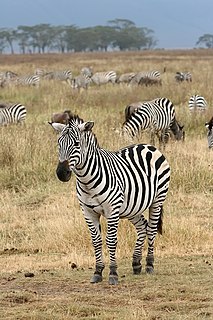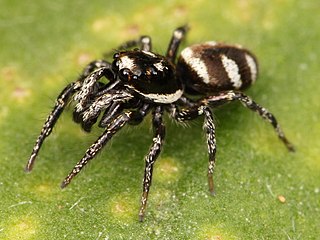
Zebras are African equines with distinctive black-and-white striped coats. There are three extant species: the Grévy's zebra, plains zebra, and the mountain zebra. Zebras share the genus Equus with horses and asses, the three groups being the only living members of the family Equidae. Zebra stripes come in different patterns, unique to each individual. Several theories have been proposed for the function of these stripes, with most evidence supporting them as a form of protection from biting flies. Zebras inhabit eastern and southern Africa and can be found in a variety of habitats such as savannahs, grasslands, woodlands, shrublands, and mountainous areas.

The Pholcidae are a family of araneomorph spiders. The family contains over 1,800 pholcids, including those commonly known as the marbled cellar spider , daddy long-legs spider, granddaddy long-legs spider, carpenter spider, daddy long-legger, vibrating spider, gyrating spider, long daddy, and skull spider. The family, first described by Carl Ludwig Koch in 1850, is divided into 94 genera.

The zebra mussel is a small freshwater mussel. The species was originally native to the lakes of southern Russia and Ukraine, but has been accidentally introduced to numerous other areas and has become an invasive species in many countries worldwide. Since the 1980s, the species has invaded the Great Lakes, Hudson River, and Lake Travis.
Zebra is the American medical slang for arriving at a surprising, often exotic, medical diagnosis when a more commonplace explanation is more likely. It is shorthand for the aphorism coined in the late 1940s by Theodore Woodward, professor at the University of Maryland School of Medicine, who instructed his medical interns: "When you hear hoofbeats behind you, don't expect to see a zebra". Since horses are common in Maryland while zebras are relatively rare, logically one could confidently guess that an animal making hoofbeats is probably a horse. By 1960, the aphorism was widely known in medical circles.

The zebra spider is a common jumping spider of the Northern Hemisphere. Like other jumping spiders it does not build a web. It has a particularly large pair of forward facing eyes that help it to locate and stalk its prey before pouncing on it. Their common name refers to their vivid black-and-white colouration, whilst their scientific name derives from Salticus from the Latin for “dancing”, in reference to their agility, and the Greek scenicus, translating to “theatrical” or “of a decorative place,” in reference to the flashy, zebra-like coloration of the species.

Caladenia, commonly known as spider orchids, is a genus of 350 species of plants in the orchid family, Orchidaceae. Spider orchids are terrestrial herbs with a single hairy leaf and a hairy stem. The labellum is fringed or toothed in most species and there are small projections called calli on the labellum. The flowers have adaptations to attract particular species of insects for pollination. The genus is divided into three groups on the basis of flower shape, broadly, spider orchids, zebra orchids and cowslip orchids, although other common names are often used. Although they occur in other countries, most are Australian and 136 species occur in Western Australia, making it the most species-rich orchid genus in that state.

Caponiidae is a family of ecribellate haplogyne spiders that are unusual in a number of ways. They differ from other spiders in lacking book lungs and having the posterior median spinnerets anteriorly displaced to form a transverse row with the anterior lateral spinnerets. Most species have only two eyes, which is also unusual among spiders. A few species of Caponiidae variously have four, six or eight eyes. In some species the number of eyes will increase when the spiderling changes its skin as it grows towards adulthood.
Nopsides is a monotypic genus of North American araneomorph spiders in the family Caponiidae, containing the single species, Nopsides ceralbonus. It is one of three nopine species, in addition to Tarsonops and Orthonops, described by Ralph Vary Chamberlin from specimens collected from the Baja California region and nearby islands in 1924. They are active during the night, hiding under large stones of Mexico's deserts and xeric shrublands during the day.
Azilia affinis is a species of long-jawed orb weaver in the family of spiders known as Tetragnathidae. It is found in a range from the United States to Panama.

Olios giganteus is a species of giant crab spider in the family Sparassidae. It is found in the United States and Mexico.

Helophora insignis is a species of sheetweb spider in the family Linyphiidae. It is found in North America, Europe, Caucasus, a range from Russia, and China.

Castianeira trilineata is a species of true spider in the family Corinnidae. It is found in the United States and Canada.

Phanias albeolus is a species of jumping spider in the family Salticidae. It is found in the United States.
Castianeira thalia is a species of true spider in the family Corinnidae. It is found in the United States.
Calymmaria suprema is a species of true spider in the family Cybaeidae. It is found in the United States and Canada.

Castianeira walsinghami is a species of true spider in the family Corinnidae. It is found in the United States and Canada.

Cryphoeca montana is a species of true spider in the family Cybaeidae. It is found in the United States and Canada.

Gnaphosa sericata is a species of ground spider in the family Gnaphosidae. It is found in a range from the United States to Guatemala and Cuba.
Tenuiphantes zebra is a species of sheetweb spider in the family Linyphiidae. It is found in North America.












